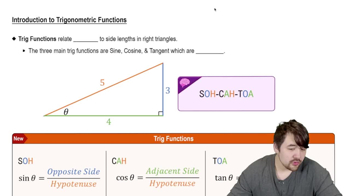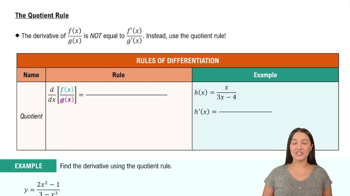Table of contents
- 0. Functions7h 52m
- Introduction to Functions16m
- Piecewise Functions10m
- Properties of Functions9m
- Common Functions1h 8m
- Transformations5m
- Combining Functions27m
- Exponent rules32m
- Exponential Functions28m
- Logarithmic Functions24m
- Properties of Logarithms34m
- Exponential & Logarithmic Equations35m
- Introduction to Trigonometric Functions38m
- Graphs of Trigonometric Functions44m
- Trigonometric Identities47m
- Inverse Trigonometric Functions48m
- 1. Limits and Continuity2h 2m
- 2. Intro to Derivatives1h 33m
- 3. Techniques of Differentiation3h 18m
- 4. Applications of Derivatives2h 38m
- 5. Graphical Applications of Derivatives6h 2m
- 6. Derivatives of Inverse, Exponential, & Logarithmic Functions2h 37m
- 7. Antiderivatives & Indefinite Integrals1h 26m
- 8. Definite Integrals4h 44m
- 9. Graphical Applications of Integrals2h 27m
- 10. Physics Applications of Integrals 2h 22m
3. Techniques of Differentiation
Derivatives of Trig Functions
Problem 3.5.29a
Textbook Question
Find the derivative of the following functions.
y = cos x/sin x + 1
 Verified step by step guidance
Verified step by step guidance1
Step 1: Recognize that the function y = \frac{\cos x}{\sin x} + 1 can be rewritten as y = \cot x + 1, where \cot x is the cotangent function.
Step 2: Recall the derivative of the cotangent function: \frac{d}{dx}(\cot x) = -\csc^2 x.
Step 3: Differentiate the function y = \cot x + 1 with respect to x. The derivative of a constant (1 in this case) is 0.
Step 4: Apply the derivative rule from Step 2 to find the derivative of \cot x, which is -\csc^2 x.
Step 5: Combine the results from Steps 3 and 4 to express the derivative of the entire function: \frac{dy}{dx} = -\csc^2 x.
 Verified video answer for a similar problem:
Verified video answer for a similar problem:This video solution was recommended by our tutors as helpful for the problem above
Video duration:
3mPlay a video:
Was this helpful?
Key Concepts
Here are the essential concepts you must grasp in order to answer the question correctly.
Derivative
The derivative of a function measures how the function's output value changes as its input value changes. It is defined as the limit of the average rate of change of the function over an interval as the interval approaches zero. In calculus, the derivative is often denoted as f'(x) or dy/dx, and it provides critical information about the function's behavior, such as its slope and points of tangency.
Recommended video:

Derivatives
Trigonometric Functions
Trigonometric functions, such as sine (sin) and cosine (cos), are fundamental in calculus, especially when dealing with periodic phenomena. These functions relate angles to ratios of sides in right triangles and are essential for modeling oscillatory behavior. Understanding their derivatives, such as the fact that the derivative of cos(x) is -sin(x) and the derivative of sin(x) is cos(x), is crucial for solving problems involving these functions.
Recommended video:

Introduction to Trigonometric Functions
Quotient Rule
The quotient rule is a method for finding the derivative of a function that is the ratio of two other functions. If y = u/v, where u and v are both differentiable functions, the derivative is given by y' = (v * u' - u * v') / v^2. This rule is particularly useful when differentiating functions like y = cos(x)/sin(x) + 1, as it allows for the systematic calculation of the derivative of the quotient of trigonometric functions.
Recommended video:

The Quotient Rule

 3:53m
3:53mWatch next
Master Derivatives of Sine & Cosine with a bite sized video explanation from Callie
Start learning




